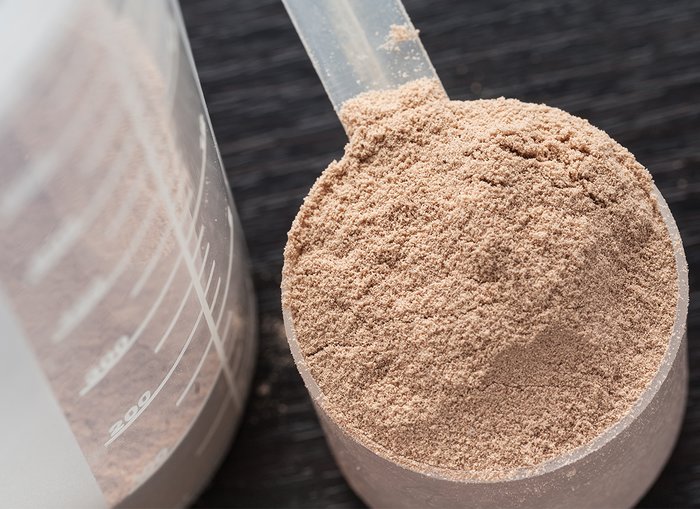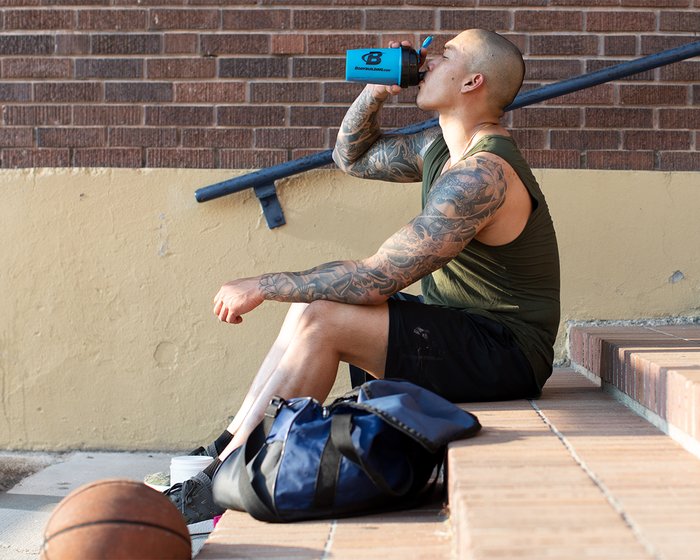Products You May Like
So, you injured yourself lifting weights? You’re not alone.
I recently suffered a complete tear of my pectoralis major tendon while performing a barbell bench press. The weight I was using would put me into the powerlifting category. I had to have surgery and was immobilized in an arm sling for six weeks. If your injury is severe enough to keep you from training for more than two weeks, your body is likely to respond negatively.
Specifically, you may lose muscle, strength, and function. And when you lose muscle, protein synthesis decreases and muscle resists anabolic stimulation, meaning the ability to respond to growth stimuli.
Follow these tips during an extended break from training and keep your losses to a minimum!
1. Track Your Protein Intake
During the initial healing process of an immobilized limb, your calories should remain about the same as usual. It’s not the time to try and cut weight or bulk up. If you’re burning more calories than you’re consuming, you may not have enough energy to heal wounds properly and stall muscle loss. On the other hand, getting too many calories while you’re unable to do cardio, lift weights, or both can result in decreased insulin sensitivity and an increase in body fat. What matters even more than daily caloric intake during injury recovery is your daily protein intake.[1]

Aim for 25-30 grams of protein per meal for a total of 1.0-1.5 grams of protein per pound of body weight per day. This is similar to what most male and female weightlifters would consume during intense training. A sudden and dramatic decrease in protein when you’re injured will lead to a negative nitrogen balance, resulting in impaired wound healing and/or increased muscle loss. The best way to track protein intake is to use a food scale to measure the weight of the fresh protein you eat (for example, chicken, fish, quinoa) and do the math to determine how many grams of protein are in that serving. What you don’t get from whole foods can be made up for with a high-quality protein powder such as COR-Performance Whey.
2. Don’t Eat Out Often
Being unable to walk, drive, or cook with two hands may seem like the perfect excuse to eat at restaurants every night, but this is not the time. Think of it as a time to experiment with new recipes, or consider using a prepared meal delivery/grocery service so you can save time and energy by not having to cook. The main thing to focus on is eating a healthy, nutritious diet, which is much easier to do at home than it is if you’re going out regularly. Now more than ever, especially limit fast food and bar food. And of course, avoid alcohol as much as possible, since that will add to the catabolism, aka protein breakdown, you’re already experiencing.
3. Break Out the BCAAS
Our bodies have 20 amino acids. Five are nonessential, meaning they can be produced by the body. Nine are essential and must be consumed in the diet. Six are conditionally essential, meaning that they become essential during periods of high exertion and stress.

Of the nine essential amino acids, three are called branched-chain amino acids (BCAAs), and research has shown their benefits in a wide range of exercise and performance metrics.[2] The BCAA that does the most is leucine, which stimulates protein synthesis through the mTOR signaling pathway.
I took (and continue to take) Cellucor Alpha Amino Ultimate nearly every day to prevent a negative nitrogen balance. It has 5 grams of BCAAs, with 2.5 grams of leucine, per scoop. It also has HMB, another promising muscle-building compound, as well as small amounts of glutamine and creatine, magnesium, potassium, coconut water powder, and more.
4. Go for Glutamine
Glutamine is one of the conditionally essential amino acids. It’s hard to tell just when glutamine becomes “essential,” to be consumed in the diet, but it’s usually in response to major surgeries, multiple traumas, and burns. Glutamine serves many functions in the human body, including maintaining a healthy gut, transporting nitrogen, and aiding in the creation of glucose, arginine, and glutathione, which is an antioxidant. Patients with severe injuries are often given glutamine via feeding tubes to help support an immune system that is already working at maximum.
During catabolic periods, such as when you’re immobilized, glutamine is released in larger-than-normal quantities to perform essential bodily functions. To compensate for the increased demand, it may be beneficial to take supplemental glutamine. After my pectoral reconstruction surgery, I took one serving of Cellucor Cor-Performance Glutamine 4-5 times per week. It’s unflavored, so it mixes well with orange juice, protein powder, and, of course, water.
5. Drink Enough Water
Try to drink a little over a gallon of water per day. Your new form of exercise during injury recovery will be using the bathroom. It’s essential to stay hydrated while you’re dealing with the inflammation of a muscular injury. Dehydration combined with a lack of nutrients and a physical injury equals a bad time.

6. Eat the Right Roots
Two root vegetables can have significant positive effects on health: beet and turmeric root. One study found that 80 milligrams of curcumin, the active compound in turmeric, decreased triglycerides and increased nitric oxide in healthy people.[3] Nitric oxide helps blood circulation, which is key when part of your body may not be able to move. Keeping blood chemistry in check while you’re exercising less is also important for overall health.
Beets are fibrous plants that have a deep red color. They have been shown to improve endurance performance by enabling athletes to last longer during workouts.[4] They also increase nitric oxide levels substantially—and at a higher scale than curcumin. If you’re able to do cardio, add beets to your diet to get more out of your workouts.
Luckily, suffering an injury while lifting is the exception. However, if it happens, you’ll likely recover with the same function and strength that you had before if you stay productive and healthy while on the shelf.
References
- Tipton, K. D. (2015). Nutritional support for exercise-induced injuries. Sports Medicine, 45(1), 93-104.
- Crowe, M. J., Weatherson, J. N., & Bowden, B. F. (2006). Effects of dietary leucine supplementation on exercise performance. European Journal of Applied Physiology, 97(6), 664-672.
- DiSilvestro, R. A., Joseph, E., Zhao, S., & Bomser, J. (2012). Diverse effects of a low dose supplement of lipidated curcumin in healthy middle aged people. Nutrition journal, 11(1), 79.
- Domínguez, R., Cuenca, E., Maté-Muñoz, J. L., García-Fernández, P., Serra-Paya, N., Estevan, M. C. L., Herreros, P.V. & Garnacho-Castaño, M. V. (2017). Effects of beetroot juice supplementation on cardiorespiratory endurance in athletes. A systematic review. Nutrients, 9(1), 43.
